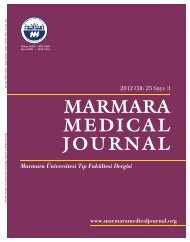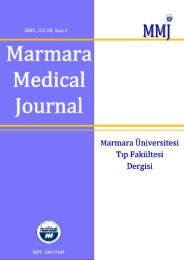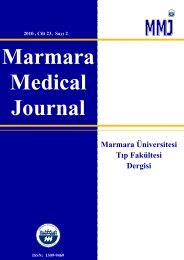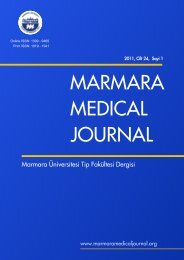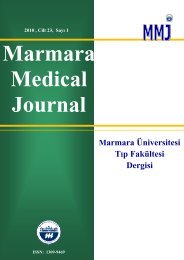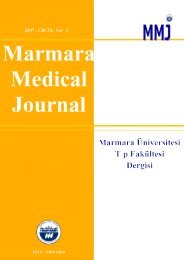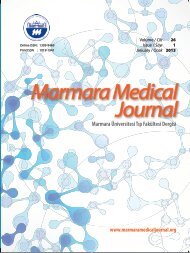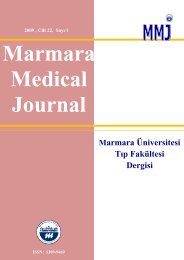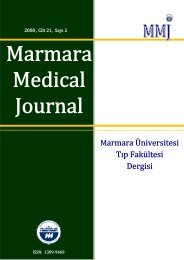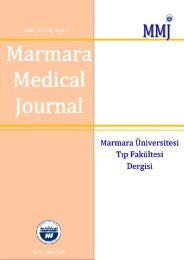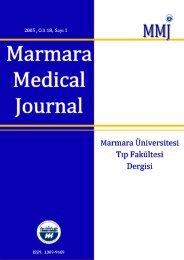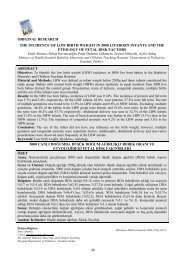Tam Metin PDF (4158 KB) - Marmara Medical Journal
Tam Metin PDF (4158 KB) - Marmara Medical Journal
Tam Metin PDF (4158 KB) - Marmara Medical Journal
- No tags were found...
You also want an ePaper? Increase the reach of your titles
YUMPU automatically turns print PDFs into web optimized ePapers that Google loves.
F. AKMAN, et alChloroquine and hydroxychloroquine maculopathyThere is no consensus in different parts ofthe world about the screening frequency for “highrisk” or “low risk” patients, and there is no standardtest for screening to detect early maculopathy 1-9 . Butthere is a world wide acceptance in the descriptionof low or high risk patients and we also use thesame terminology in our clinic. The Royal College ofOphtalmologists guidelines recommend a baselineophthalmic examination including best correctedvisual acuity, fundoscopy, and a central visual fieldtest 8 . Patients should be warned to report any visualdisturbance and may be given an Amsler chart touse monthly. No further ophthalmic examination isneeded unless the patient is symptomatic 8 .The most frequently used follow up testsare Amsler grid and 10/2 visual field testing whichconcern examination of the macula. However,some centers use 40/2 visual field testing for followup, as was the situation in Case 1. There are alsosome new tests mentioned in the literature, pointingto early detection of maculopathy, such asmultifocal ERG (mfERG), high speed ultra highresolution optical coherence tomography (hsUHR-OCT) and blue-yellow perimetry. The sensitivity andspecifity of these tests are not yet known and theavailability and interpretation of these test resultsare a great concern 9-11 .The two cases of advanced maculopathymentioned here were diagnosed during a 5 yearperiod (5 years and 3 months in Case 1; 3 yearsand 4 months in Case 2). These cases are bothestablished maculopathy cases, where toxicitypossibly started months before the diagnosis. InCase 1, the test results were misinterpreted by thepatient’s rheumatologist and she should have beenreferred to an ophthalmologist. In Case 2, thepatient was poorly informed about the importance offollow up procedures. The information procedureshould be done more seriosly. We are nowpreparing a more detailed “patients’ informedconsent form” in our clinic and we are going topublish the results of our clinical protocol which wasprepared in accordance with the screening methodsmentioned in studies from our country 12,13 .Although the mentioned doses aremonitored and most patients are under control,there are still some patients suffering fromretinopathy. Since 2002, 16 more cases have beenreported in the literature, suffering from antimalarialretinopathy. We now add two more cases to these 14 .Advanced cases of maculopathy havebeen considered rare, but still continue to bediagnosed in the community. Thus, we still needbetter screening protocols and we still need to findbetter ways to inform patients about the first signs ofmaculopathy to eliminate this irreversibile butpreventable dramatic result.REFERENCES1. Marmor FM. New American Academy ofOphtalmology recommendations on screeningfor hydroxychloroquine retinopathy. ArthritisRheum 2003 Jun;48(6):1764. doi:10.1002/art.109802. Browning DJ. Hydroxychloroquine andchloroquine retinopathy: screening for drugtoxicity. Am J Ophthalmol. 2002;133: 649- 656.doi: 10.1016/S0002-9394(02)01392-23. Easterbrook M. Screening for antimalarialtoxicity: current concepts. Can J Ophtalmol.2002; 6:325- 328.4. Tehrani R, Ostrowski RA, Hariman R, Jay WM.Ocular toxicity of hydroxychloroquine. SeminOphtalmol. 2008; 23 :201- 209. doi:10.1080/088205308020499625. Rigaudière F, Ingster-Moati I, Hache JC, Leid J,Verdet R, Haymann P, Rigolet MH, Zanlonghi X,Defoort S, Le Gargasson JF: Updatedophtalmological screening and follow upmanagement for long term antimalarialtreatment. J Fr Ophtalmol 2004; 27:191- 199.6. Rüther K, Foerster J, Berndt S, et al.Chloroquine/hydroxychloroquine:variability ofretinotoxic cumulative doses. Ophthalmologe2007;104:875-879. doi: 10.1007/s00347-007-1560-77. Pluta JP, Rühter K. Retinal damage by(hydroxyl)chloroquine intake:published evidencefor an efficient ophthalmological follow-up. KlinMonbl Augenheilkd 2009;226:891-896. Epub2009 Nov. 13. doi 10.1055/s-0028-11098818. Blyth C, Lane C: Hydroxychloroquineretinopathy:is screening necessary? BMJ. 1998;316 :716– 7179. Gilbert ME, Savino PJ: Missing the bull’s eye.Surv Ophtalmol 2007; 52 :440- 442.10. Rodriguez-Padilla JA, Hedges TR 3rd, MonsonB, Srinivasan V, Wojtkowski M, Reichel E, DukerJS, Schuman JS, Fujimoto JG: High speed ultrahigh resolution optical coherence tomographyfindings in hydroxychloroquine retinopathy. ArchOphtalmol 2007; 125: 775- 780.11. Razeghinejad MR, Torkaman F, Amini H: Blueyellow perimetry can be an early detector ofhydroxychloroquine and chloroquine retinopathy.Med Hypotheses 2005; 65 :629- 630. doi:10.1016/j.mehy.2005.04.00512. Gündüz K, Okka M, Zengin N, Okudan S,Özbayrak N,Acaroğlu Ş. Klorokin tedavisinderetina toksisitesinin araştırılması. T KlinOftalmoloji 1995; 4: 47-51.13. Köse S, Akkın C, Ya_cı A, Ate_ H,Haznedaro_luG. Klorokin retinopatisinin saptanması veizlenmesinde kullanılan yöntemlerin etkinliği. MNOftalmoloji 1993; 2: 299-301.14. Herman K, Leys A,Spileers W:Hydroxychloroquine retinal toxicity: two casereports and safety guidelines. Bull Soc BelgeOphtalmol 2002; 284: 21- 29.72<strong>Marmara</strong> <strong>Medical</strong> <strong>Journal</strong> 2011; 24 (1):68-72



